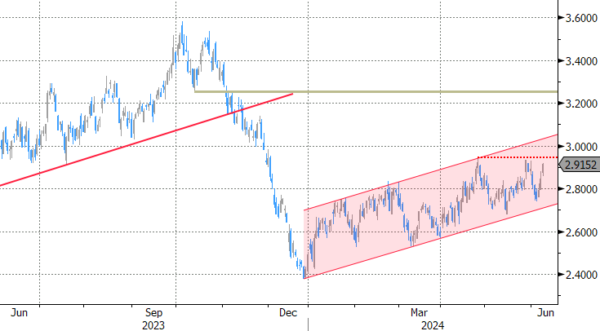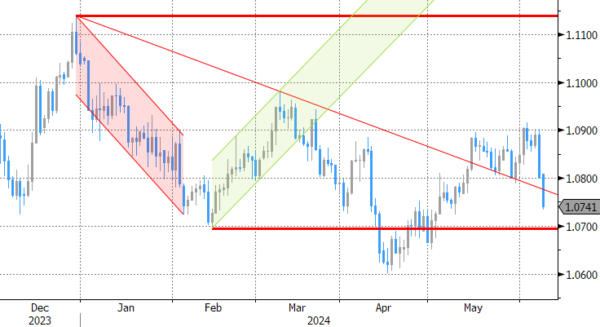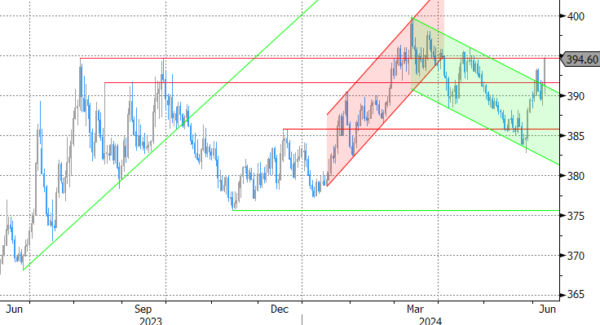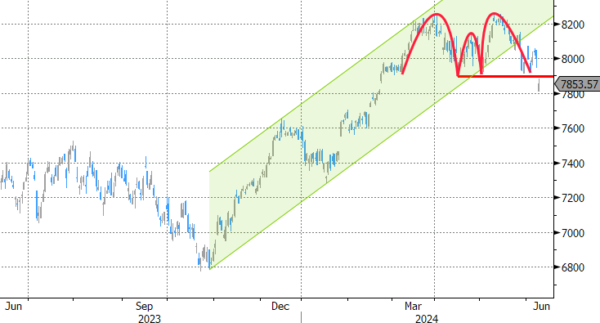Markets
Elections for the European Parliament this time didn’t pass unnoticed on European markets. They clearly left investors with quite a degree of unease. The ‘gamble’ of French President Macron to call snap elections in an attempt to block the ascent of the far-right Rassemblement National (RN) illustrates the difficulties of center parties to politically stay in the driver’s seat and to execute their (reform) programs. The situation in countries like Germany (steep loss for the ruling coalition and gain of far right) or Italy (Brothers of Italy win) is not unequivocally the same, but there are some resemblances. Anyway, this context might reduce visibility on the budgetary and debt trajectory for the countries involved. Whatever the analysis, risk premia on European assets rose today. The Eurostoxx 50 is ceding more 1%. French equities underperform (-1.6%). EUR/USD maintains weekend losses to trade near 1.0750. 10-y spreads vs Germany for the likes of France and Italy are rising 6 bps and this trend in a more benign way also applies to most other intra-EMU bonds. Still, this broader E(M)U risk-off doesn’t help Bunds to play a safe haven role. German yields also add between 0.5 bps (2-y) and 7.5 bps (30-y). Evidently, considerations on future ECB monetary policy are also in play as a potential explanation for the rise in European/German yields. In this respect, ECB members tempered expectations for further ECB rate cuts. German Bundesbank Nagel indicated that the ECB is not necessarily at the starting point of a protracted rate cut cycle yet. ECB’s Kazimir put forward the September meeting/forecasts as a next evaluation point to see whether the ECB can cut rates again. Still EMU bonds largely underperform Treasuries even after strong US payrolls last Friday and with US markets counting down to US May CPI release and the Fed policy decision (including new projections/dots) both scheduled on Wednesday. In a steepening move, US yields are changing between -1 bp (2-y) and +3 bps (30-y). Economic data are close to non-existent today but later, the US Treasury will start its refinancing operation selling $58bn of 3-y notes. Recall that the previous series (2, 5 and 7-y bonds) two weeks ago only met mediocre investor interest. Brent oil after losses early last week, extends its rebound north of $80/b.
The EMU-related risk-off not only keeps the euro in the defensive against the dollar but also against most smaller regional currencies. The Swiss franc resumes it rebound since late May (EUR/CHF 0.9337). Sterling decisively cleared the EUR/GBP 0.85 barrier, currently trading below 0.845. Even the likes of the Swedish krone outperform, despite a series of unconvincing Swedish data published today (EUR/SEK 11.336). CE currency prove more vulnerable to the overall risk-off context (cf infra).
News & Views
Hungarian prices fell by 0.1% M/M in May while consensus expected a 0.1% increase. The highest price increase of 0.9% was measured for services. Food became 0.1% more expensive on average. Electricity, gas and other fuel prices fell by 0.9% M/M with fuel prices down 4.4%. On an annual basis, Hungary inflation as a result rose less than forecast (4% Y/Y from 3.7% vs 4.2% expected). Services prices are 9.5% more expensive while food is up 1%. Consumers paid 1.7% less for consumer durables. Electricity, gas and other fuels became 2.9% cheaper. The Hungarian forint lost significant ground even against a weaker euro. EUR/HUF rose from 390 to 394.50, the weakest HUF-level since the end of April. Significantly higher core bond yields are at least as accountable the inflation numbers. The likes of the Czech koruna (EUR/CZK 24.66) and Polish zloty (EUR/PLN 4.33) also face selling pressure today.
Norwegian inflation fell by 0.1% M/M as well in May with the Y/Y-disinflation process continuing from 3.6% to 3.3% for the headline number (lowest since July 2021). Housing, water, electricity, gas and other fuels prices were the main culprit (-2% M/M) with communications being the sole other price category in decline (-0.6% M/M). Underlying core inflation rose as expected by 0.5% M/M with the Y/Y-figure slowing from 4.4% to 4.1% (lowest since June 2022). The underlying core inflation pace strengthens the Norges Bank view that the current policy rate (4.5%) may remain in place for somewhat longer than previously envisaged (first rate cut in winter rather than autumn). The krone didn’t respond to the data with EUR/NOK a tad softer at 11.52.
Graphs
EMU 10-y swap rate: LT EMU yields jump on higher risk premia after EU parliamentary elections
EUR/USD nosedives in 1.06/1.09 trading range on both USD strength and euro weakness
EUR/HUF: forint under pressure on softer-than-expected inflation and global EU-related risk-off
CAC 40 tumbles below first important support as president Macron makes the gamble of snap elections

















